An Analytical Model for Capturing the Decline of Fracture Conductivity in the Tuscaloosa Marine Shale Trend from Production Data
Abstract
:1. Introduction
2. Mathematical Model
- The oil formation is isotropic.
- Boundary-dominated flow has been reached within the fracture drainage area.
- Linear flow prevails from the shale matrix to the fractures.
- Fracture and formation damages are negligible.
- No change in fluid composition during production.
- Hydraulic fractures have the same geometry.
- Reservoir pressure is above the bubble point pressure.
3. Flow Regime Diagnosis
3.1. Flow Regime Diagnosis Method
3.2. TMS Well Description
3.3. Flow Regimes of TMS Wells
4. Model Verification
4.1. Verification of the Model on Simulated Production Dataset
4.2. Analysis of TMS Well Data
5. Variation of Fracture Conductivity
6. Discussion
7. Conclusions
- (1)
- The log-log diagnostic approach was used to identify the boundary-dominated flow regime of seven TMS wells. The results indicated that these seven wells exhibited a long-term transient flow period.
- (2)
- The R-square and AAREP were utilized in this study to estimate the performance of the proposed analytical well productivity model considering time-dependent fracture conductivity. The results indicated that the proposed model allows approximation of the real production data of the project wells in TMS formation with good accuracy.
- (3)
- The proposed fracture conductivity model was verified against simulated production data for a wide range of fracture conductivities/compressibilities. The results indicated that the predicted fracture compressibilities agree well with the prescribed values, with relative differences of fracture compressibility that were less than 10%.
- (4)
- The revealed average fracture conductivity decreases over time in the range of 100%-48% of the initial fracture conductivity. The pressure-dependent decline of fracture conductivity can be approximated using a logarithmic function given by equation (6) with the dimensionless coefficient χ varying between 0.116 and 0.130.
Author Contributions
Funding
Conflicts of Interest
Nomenclature
| A | constant defined by Equation (1) |
| AAREP | average absolute relative error percentage |
| Bo | oil formation factor, rb/stb |
| c | defined by Equation (1) |
| c1 | defined by Equation (A12) |
| c2 | defined by Equation (A14) |
| Cf | fracture conductivity, md-ft |
| Cf0 | initial fracture conductivity, md-ft |
| cp | compressibility of the proppant pack, psia−1 |
| cp0 | initial compressibility of the proppant pack, psia−1 |
| ct | total reservoir compressibility, psia−1 |
| Ei | model-predicted production rate, stb/d |
| h | fracture height, ft |
| kf | fracture permeability, md |
| kf0 | initial fracture permeability, md |
| km | matrix permeability, md |
| N | number of production data points |
| nf | number of hydraulic fractures |
| Ni | initial oil in place in the drainage area of the well, stb |
| Np | cumulative oil production from the well, stb |
| Np1 | cumulative oil production at point 1, stb |
| Np2 | cumulative oil production at point 2, stb |
| Oi | observed production rate, stb/d |
| pi | initial reservoir pressure, psia |
| average formation pressure, psia | |
| pw | wellbore pressure, psia |
| qo | oil production rate, stb/d |
| qo1 | oil production rate at point 1, stb/d |
| qo2 | oil production rate at point 2, stb/d |
| Sf | fracture spacing, ft |
| telf | time at the end of transient flow, hour |
| w | fracture width, inch |
| xf | fracture half-length, ft |
| αb | Biot coefficient |
| μo | oil viscosity, cp |
| σe | effective stress, psi |
| σe0 | initial effective stress, psi |
| ϕ | matrix porosity |
| α | decline rate of the propped fracture compressibility, psia−1 |
| ν | Poison’s ratio |
Appendix A. Derivation of Productivity Model with Pressure-Dependent Fracture Conductivity
- The oil formation is isotropic.
- Boundary-dominated flow has been reached within the fracture drainage area.
- Linear flow prevails from the shale matrix to the fractures.
- Fracture and formation damages are negligible.
- No change in fluid composition during production.
- Hydraulic fractures have the same geometry.
- Reservoir pressure is above the bubble point pressure.
- Tabulate a column of qo values from the present oil production rate to the abandonment oil production rate.
- Use a numerical algorithm to solve Equation (A9) for a column of Np values.
- Construct columns of Np.
- Construct a column of t by dividing Np by qo.
- Construct a column of t based on t = ∑Δt.
- Plot qo versus t columns for a future production curve.
References
- Allen, J.E.; Meylan, M.A.; Heitmuller, F.T. Determining hydrocarbon distribution using resistivity, Tuscaloosa Marine Shale, southwestern Mississippi. Gulf Coast Assoc. Geol. Soc. Trans. 2014, 64, 41–57. [Google Scholar]
- Besov, A.; Tinni, A.; Sondergeld, C.; Rai, C.; Paul, W.; Ebnother, D.; Smagala, T. Application of laboratory and field NMR to characterize the Tuscaloosa Marine Shale. Petrophysics 2017, 58, 221–231. [Google Scholar]
- Berch, H.; Jeffrey, N. Predicting potential unconventional production in the Tuscaloosa Marine Shale play using thermal modeling and log overlay analysis. GCAGS J. 2014, 3, 69–78. [Google Scholar]
- John, C.J.; Jones, B.L.; Moncrief, J.E.; Bourgeois, R.; Harder, B.J. An unproven unconventional seven billion barrel oil resource-the Tuscaloosa Marine Shale. LSU Basin Res. Inst. Bull. 1997, 7, 1–22. [Google Scholar]
- Stewart, G. Integrated analysis of shale gas well production data. In Proceedings of the SPE Asia Pacific Oil & Gas Conference and Exhibition, Adelaide, Australia, 14–16 October 2014. [Google Scholar]
- Yang, C.; Sharma, V.K.; Detta-Gupta, A.; King, M.J. A novel approach for production transient analysis of shale gas/oil reservoirs. In Proceedings of the Unconventional Resources Technology Conference, San Antonio, TX, USA, 20–22 July 2015. [Google Scholar]
- Bajwa, A.I.; Blunt, M.J. Early-time 1D analysis of shale-oil and -gas flow. SPE J. 2016, 21, 1254–1262. [Google Scholar] [CrossRef]
- Cheng, Y. Pressure transient characteristics of hydraulically fractured horizontal shale gas wells. In Proceedings of the SPE Eastern Regional Meeting, Columbus, OH, USA, 17–19 August 2011. [Google Scholar]
- Sun, H.; Dengen, Z.; Adwait, C.; Meilin, D. Quantifying shale oil production mechanisms by integrating a Delaware basin well data from fracturing to production. In Proceedings of the SPE/AAPG/SEG Unconventional Resources Technology Conference, San Antonio, TX, USA, 1–3 August 2016. [Google Scholar]
- Yu, W.; Yu, Y.; Wu, K.; Sepehrnoori, K. Impact of well interference on shale oil production performance: A numerical model for analyzing pressure response of fracture hits with complex geometries. In Proceedings of the SPE Hydraulic Fracturing Technology Conference and Exhibition, Woodlands, TX, USA, 24–26 January 2017. [Google Scholar]
- Ali, T.A.; Sheng, J.J. Production decline models: A comparison study. In Proceedings of the SPE Eastern Regional Meeting, Morgantown, WV, USA, 13–15 October 2015. [Google Scholar]
- Duong, A.N. An unconventional rate decline approach for tight and fracture-dominated gas wells. In Proceedings of the Canadian Unconventional Resources and International Petroleum Conference, Calgary, AB, Canada, 19–21 October 2010. [Google Scholar]
- Vanorsdale, C.R. Production decline analysis lessons from classic shale gas wells. In Proceedings of the SPE Annual Technical Conference and Exhibition, New Orleans, LA, USA, 30 September–2 October 2013. [Google Scholar]
- Mattar, L.; Moghadam, S. Modified power law exponential decline for tight gas. In Proceedings of the Canadian International Petroleum Conference, Calgary, AB, Canada, 16–18 June 2009. [Google Scholar]
- Ali, T.; Sheng, J.; Soliman, M. New production-decline models for fractured tight and shale reservoirs. In Proceedings of the SPE Western North American and Rocky Mountain Joint Meeting, Denver, CO, USA, 17–18 April 2014. [Google Scholar]
- Kenomore, M.; Hassan, M.; Malakooti, R.; Dhakal, H.; Shah, A. Shale gas production decline trend over time in the Barnett Shale. J. Pet. Sci. Eng. 2018, 165, 691–710. [Google Scholar] [CrossRef]
- Clarkson, C.R. Production data analysis of unconventional gas wells: Workflow. Int. J. Coal Geol. 2013, 109, 147–157. [Google Scholar] [CrossRef]
- Xu, B.; Haghighi, M.; Li, X.; Cooke, D. Development of new type curves for production analysis in naturally fractured shale gas/tight gas reservoirs. J. Pet. Sci. Eng. 2013, 105, 107–115. [Google Scholar] [CrossRef]
- Shin, H.J.; Lim, J.S.; Shin, S.H. Estimated ultimate recovery prediction using oil and gas production decline curve analysis and cash flow analysis for resource play. Geosyst. Eng. 2014, 7, 78–87. [Google Scholar] [CrossRef]
- Ai, K.; Duan, L.; Gao, H.; Jia, G. Hydraulic fracturing treatment optimization for low permeability reservoirs based on unified fracture design. Energies 2018, 11, 1720. [Google Scholar] [CrossRef]
- Zhou, L.; Chen, J.; Gou, Y.; Feng, W. Numerical investigation of the time-dependent and the proppant dominated stress shadow effects in a transverse multiple fracture system and optimization. Energies 2017, 10, 83. [Google Scholar] [CrossRef]
- Wang, J.; Elsworth, D.; Ma, T. Conductivity evolution of proppant-filled hydraulic fractures. In Proceedings of the 52nd U.S. Rock Mechanics/Geomechanics Symposium, Seattle, WA, USA, 17–20 June 2018. [Google Scholar]
- Awoleke, O.O.; Zhu, D.; Hill, A.D. New propped-fracture-conductivity models for tight gas sands. SPE J. 2016, 21, 1508–1517. [Google Scholar] [CrossRef]
- Chang, X.; Guo, Y.; Zhou, J.; Song, X.; Yang, C. Numerical and experimental investigations of the interactions between hydraulic and natural fractures in shale formations. Energies 2018, 11, 2541. [Google Scholar] [CrossRef]
- Zhang, J.; Ouyang, L.; Zhu, D.; Hill, A.D. Experimental and numerical studies of reduced fracture conductivity due to proppant embedment in the shale reservoir. J. Pet. Sci. Eng. 2015, 130, 37–45. [Google Scholar] [CrossRef] [Green Version]
- Teng, W.; Qiao, X.; Teng, L.; Jiang, R.; He, J. Production performance analysis of multiple fractured horizontal wells with finite-conductivity fractures in shale gas reservoirs. J. Nat. Gas Sci. Eng. 2016, 36, 747–759. [Google Scholar] [CrossRef]
- Wen, Q.; Zhang, S.; Wang, L. Influence of proppant embedment on fracture long term flow conductivity. Nat. Gas Ind. 2005, 25, 65–68. [Google Scholar]
- Sun, H.; Ouyang, W.; Zhang, M.; Tang, H.; Chen, C.; Xu, M.A. Advanced production decline analysis of tight gas wells with variable fracture conductivity. Pet. Explor. Dev. 2018, 45, 472–480. [Google Scholar] [CrossRef]
- Marsden, J.; Kostyleva, I.; Fassihi, M.R.; Gringarten, A.C. A conceptual shale gas model validated by pressure and rate data from the Haynesville Shale. In Proceedings of the SPE Annual Technical Conference and Exhibition, San Antonio, TX, USA, 9–11 October 2017. [Google Scholar]
- Zhou, P.; Pan, Y.; Sang, H.; Lee, W.J. Criteria for proper production decline models and algorithm for decline curve parameter inference. In Proceedings of the SPE/AAPG/SEG Unconventional Resources Technology Conference, Houston, TX, USA, 23–25 July 2018. [Google Scholar]
- Shi, X.; Yang, X.; Meng, Y.; Li, G. An anisotropic strength model for layered rocks considering planes of weakness. Rock Mech. Rock Eng. 2016, 49, 3783–3792. [Google Scholar] [CrossRef]
- Singh, M.; Samadhiya, N.K.; Kumar, A.; Kumar, V.; Singh, B. A nonlinear criterion for triaxial strength of inherently anisotropic rocks. Rock Mech. Rock Eng. 2015, 48, 1387–1405. [Google Scholar] [CrossRef]
- Rincones, M.D.; Lee, W.J.; Rutledge, J.M. Production forecasting for shale oil: Workflow. In Proceedings of the SPE Asia Pacific Unconventional Resources Conference and Exhibition, Brisbane, Australia, 9–11 November 2015. [Google Scholar]
- Nobakht, M.; Mattar, L. Analyzing production data from unconventional gas reservoirs with linear flow and apparent skin. J. Can. Pet. Technol. 2012, 51, 52–59. [Google Scholar] [CrossRef]
- Li, G.; Guo, B.; Li, J.; Wang, M. A mathematical model for predicting long-term productivity of modern multifractured shale gas/oil wells. SPE Drill. Completion 2019, 34. [Google Scholar] [CrossRef]
- Chen, D.; Pan, Z.; Ye, Z. Dependence of gas shale fracture permeability on effective stress and reservoir pressure: Model match and insights. Fuel 2015, 139, 383–392. [Google Scholar] [CrossRef]
- Neto, L.B.; Khanna, A.; Kotousov, A. Conductivity and performance of hydraulic fractures partially filled with compressible proppant packs. Int. J. Rock Mech. Min. Sci. 2015, 74, 1–9. [Google Scholar] [CrossRef]

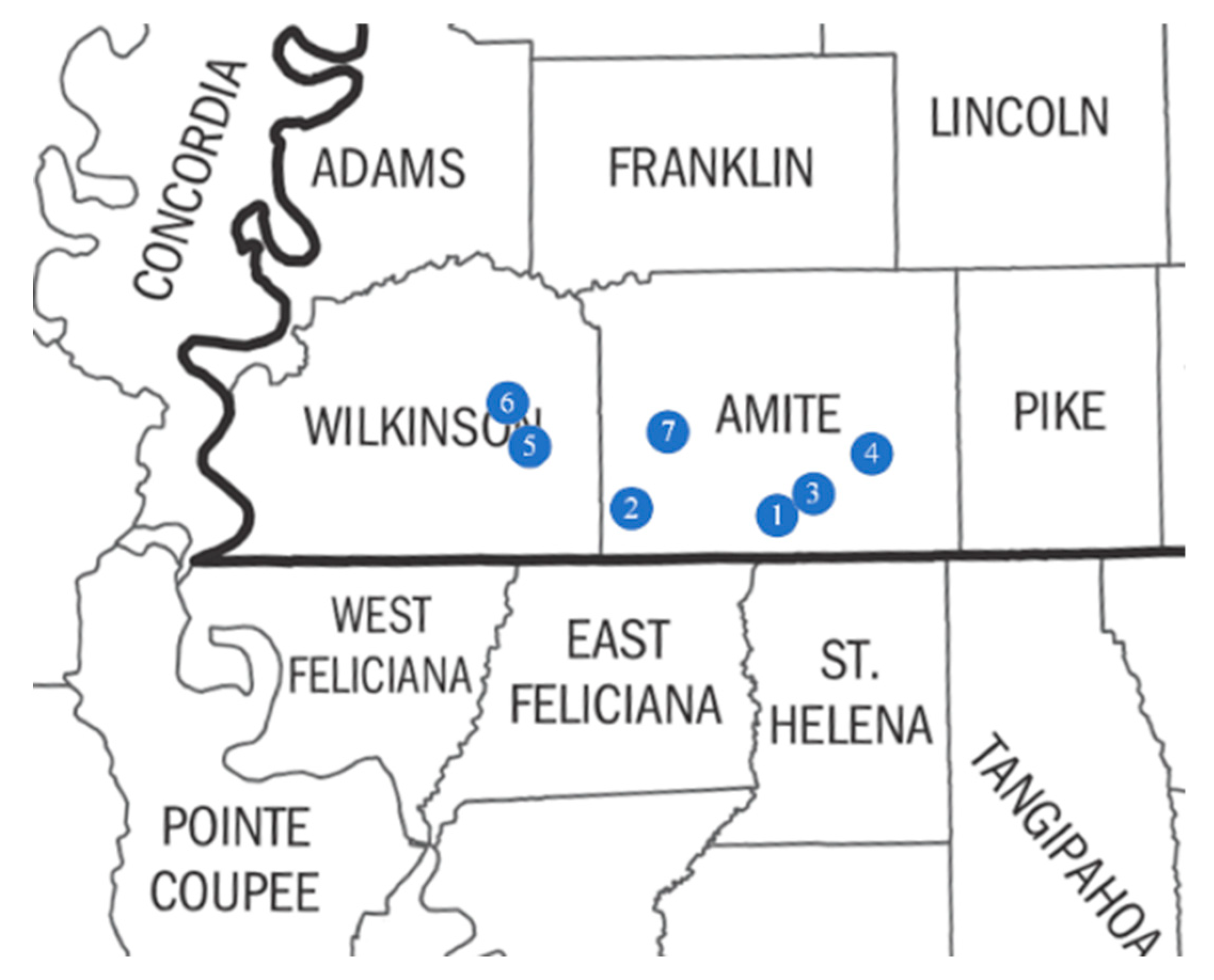

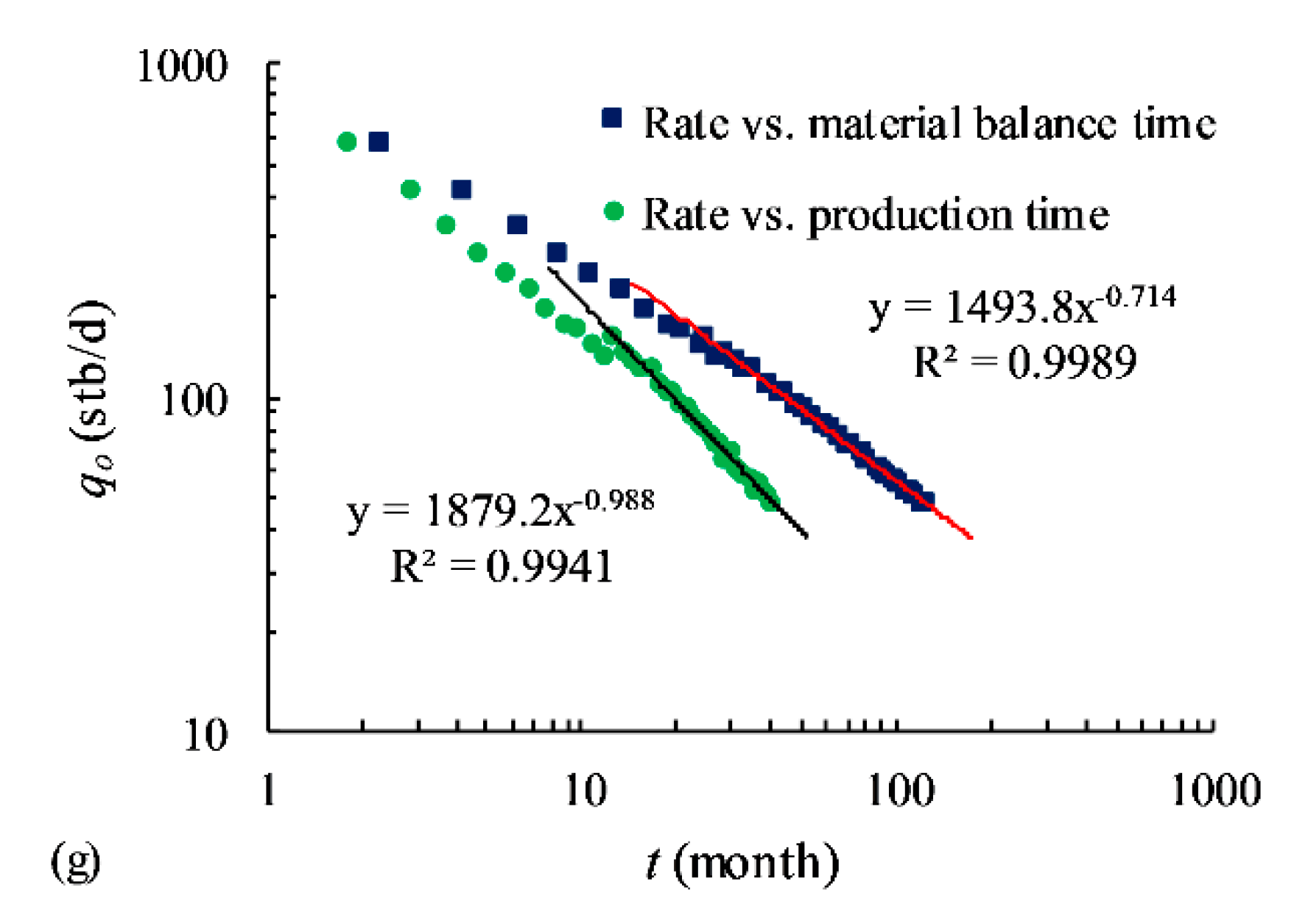

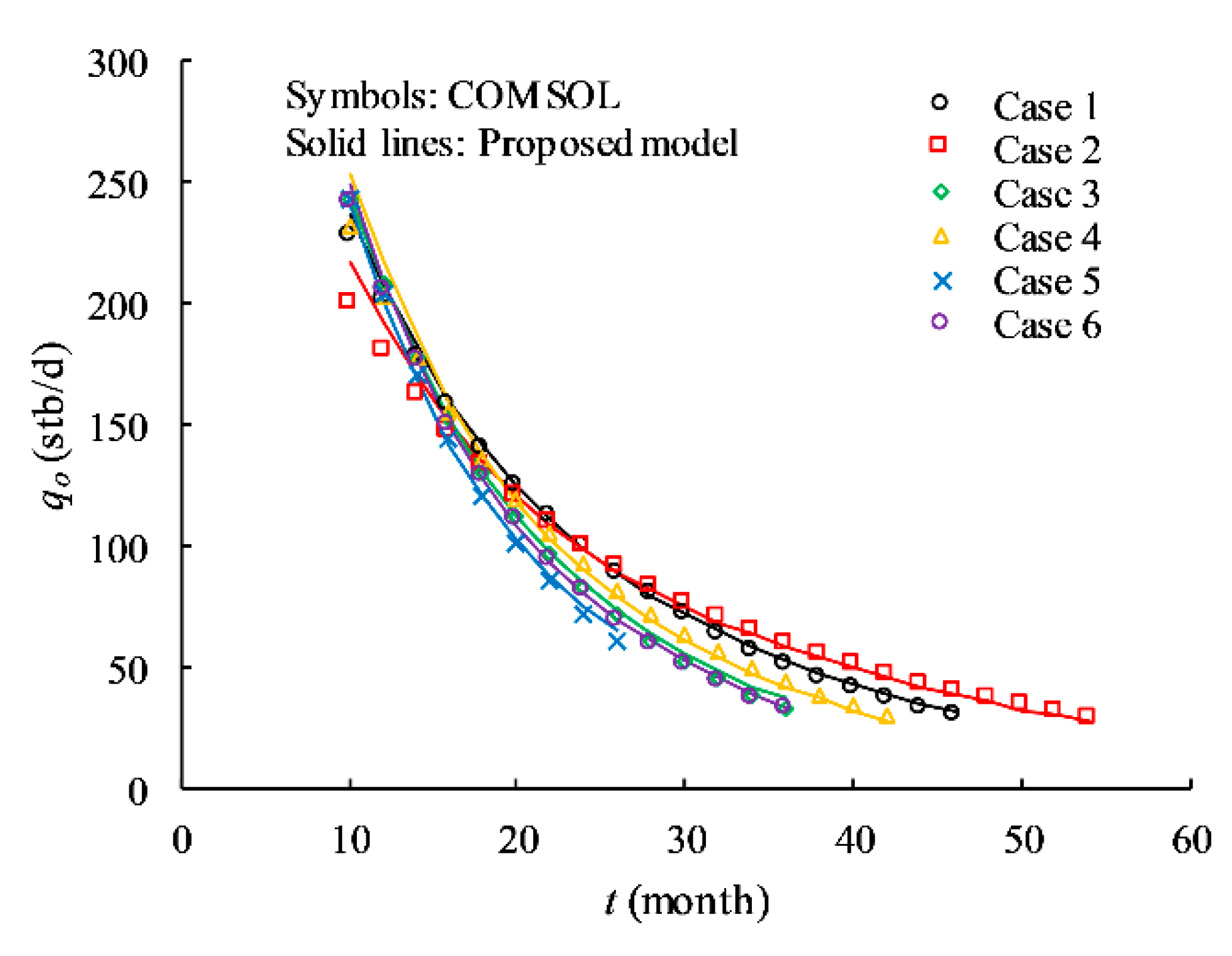
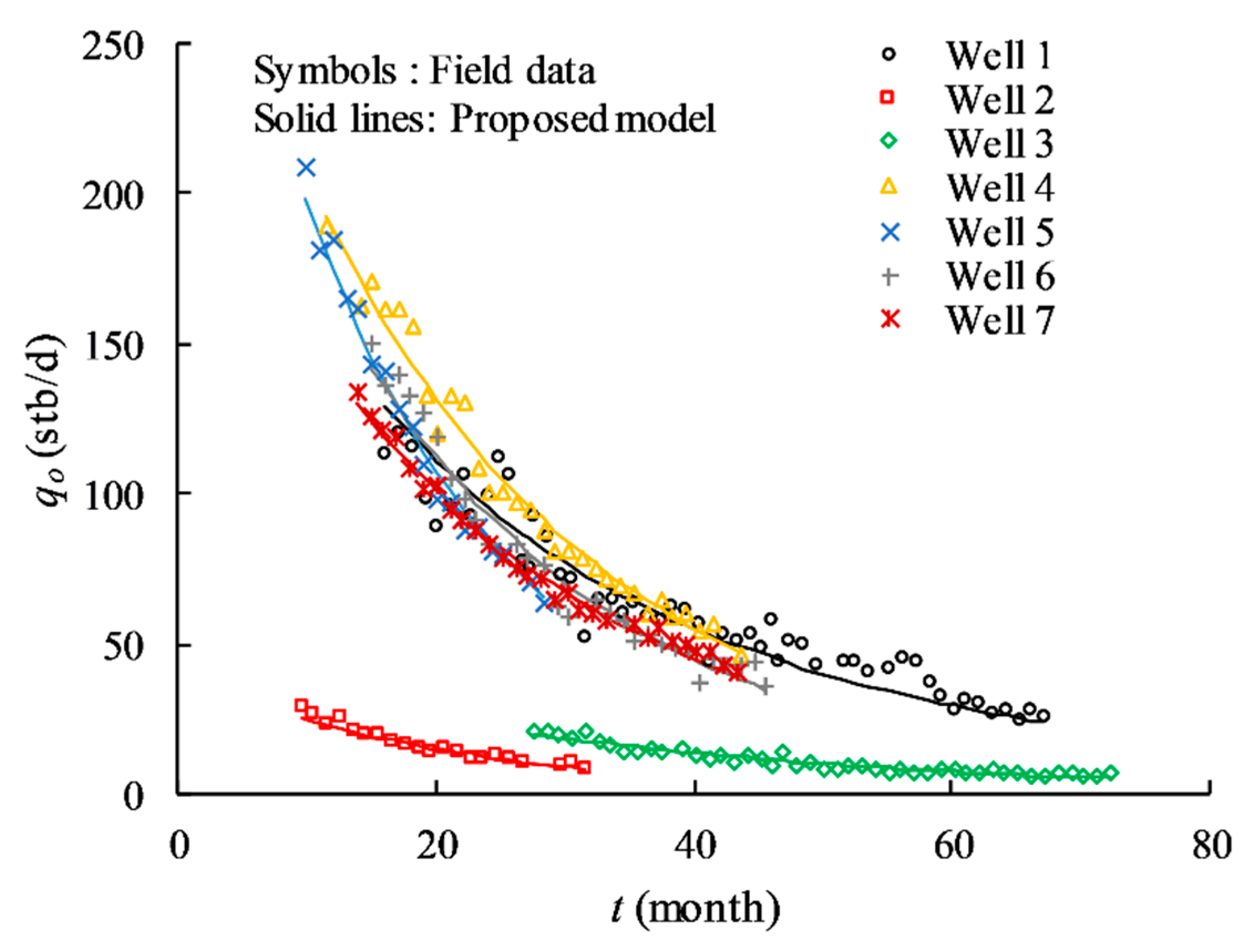
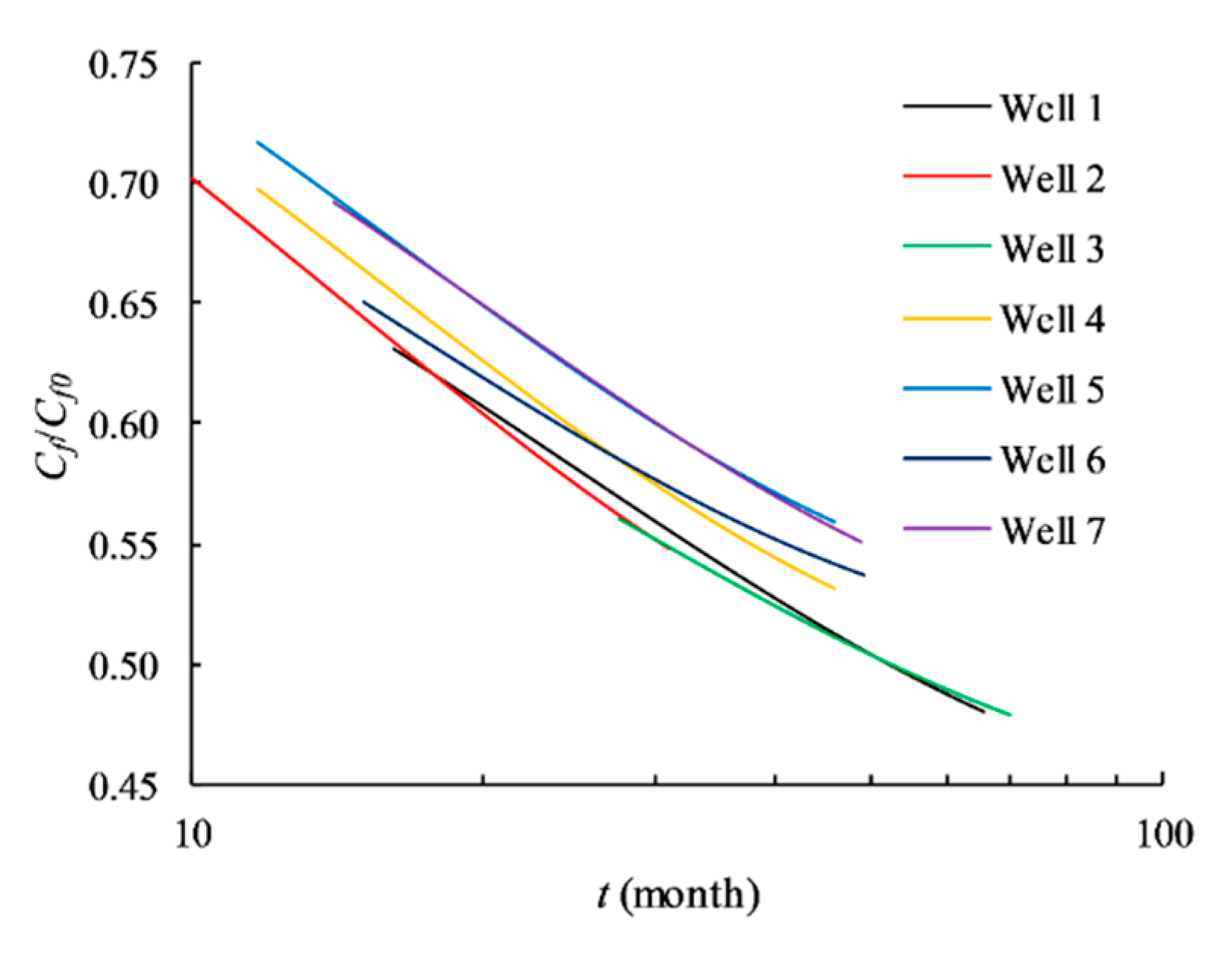
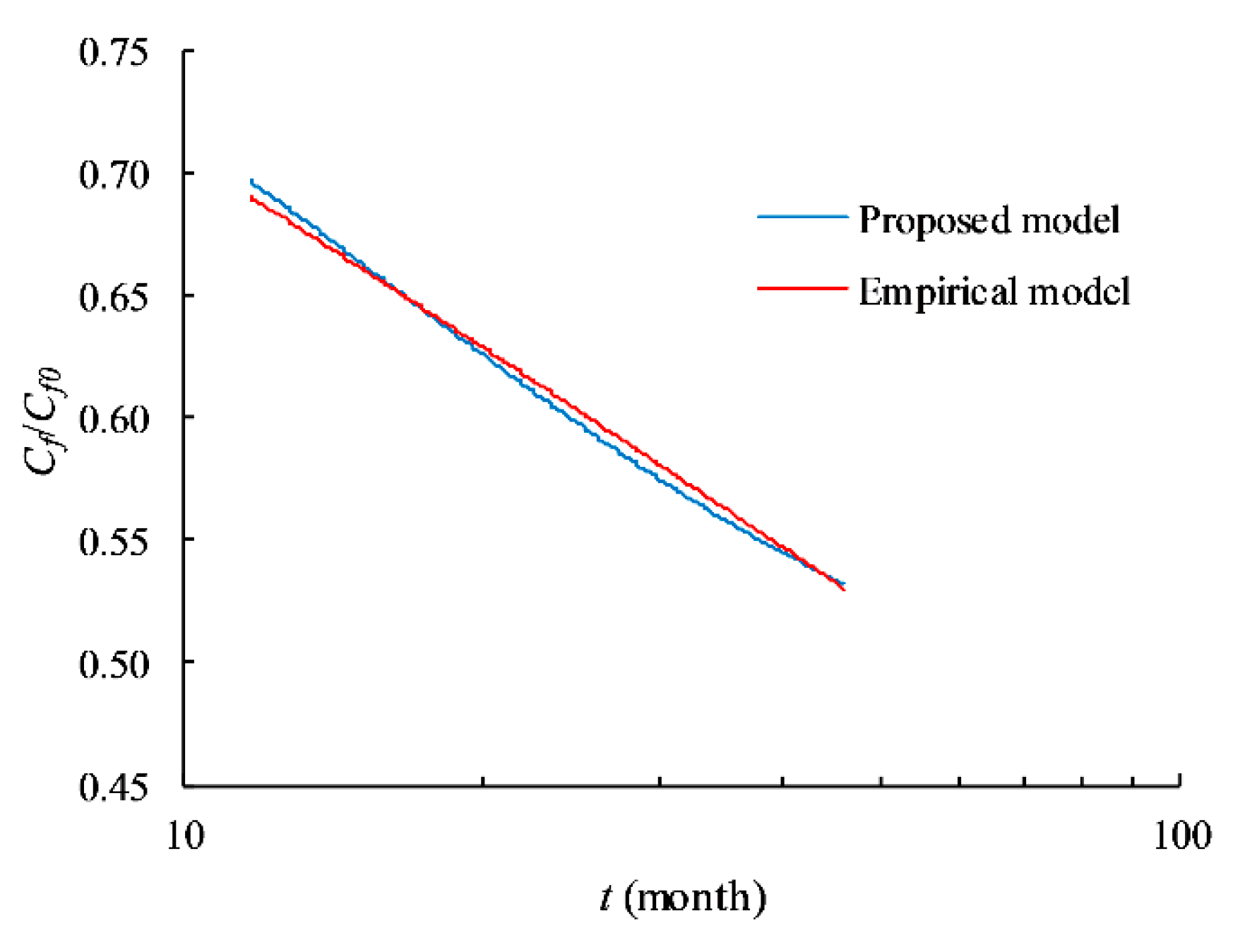
| Well Label | True Vertical Depth (ft) | Effective Lateral Length (ft) | Frac Stages |
|---|---|---|---|
| 1 | 11,783 | 8442 | 29 |
| 2 | 12,598 | 6757 | 22 |
| 3 | 11,992 | 2923 | 10 |
| 4 | 11,489 | 6451 | 26 |
| 5 | 12,245 | 5601 | 24 |
| 6 | 12,016 | 6681 | 24 |
| 7 | 11,841 | 5681 | 25 |
| No. | Oil Production rate (stb/d) | Fracture Compressibility (psia−1) | ||
|---|---|---|---|---|
| R2 | AAREP | COMSOL | Proposed Model | |
| Case 1 | 0.999 | 1.40% | 0.0005 | 0.00055 |
| Case 2 | 0.998 | 3.29% | 0.0010 | 0.00092 |
| Case 3 | 1.000 | 2.83% | 0.0005 | 0.00054 |
| Case 4 | 0.998 | 4.77% | 0.0010 | 0.00094 |
| Case 5 | 1.000 | 2.59% | 0.0005 | 0.00058 |
| Case 6 | 0.999 | 1.53% | 0.0010 | 0.00094 |
| Well Label | Fracture Compressibility (psia−1) | R2 | AAREP |
|---|---|---|---|
| 1 | 0.00052 | 0.925 | 10.38% |
| 2 | 0.00056 | 0.960 | 5.71% |
| 3 | 0.00053 | 0.937 | 8.97% |
| 4 | 0.00047 | 0.978 | 4.65% |
| 5 | 0.00048 | 0.990 | 3.09% |
| 6 | 0.00052 | 0.974 | 6.27% |
| 7 | 0.00049 | 0.988 | 3.76% |
| Well Label | χ | R2 | AAREP |
|---|---|---|---|
| 1 | 0.127 | 0.998 | 0.86% |
| 2 | 0.130 | 0.999 | 0.71% |
| 3 | 0.127 | 0.997 | 1.51% |
| 4 | 0.122 | 0.997 | 0.60% |
| 5 | 0.116 | 0.997 | 0.50% |
| 6 | 0.123 | 0.995 | 1.07% |
| 7 | 0.116 | 0.998 | 0.28% |
© 2019 by the authors. Licensee MDPI, Basel, Switzerland. This article is an open access article distributed under the terms and conditions of the Creative Commons Attribution (CC BY) license (http://creativecommons.org/licenses/by/4.0/).
Share and Cite
Yang, X.; Guo, B.; Zhang, X. An Analytical Model for Capturing the Decline of Fracture Conductivity in the Tuscaloosa Marine Shale Trend from Production Data. Energies 2019, 12, 1938. https://doi.org/10.3390/en12101938
Yang X, Guo B, Zhang X. An Analytical Model for Capturing the Decline of Fracture Conductivity in the Tuscaloosa Marine Shale Trend from Production Data. Energies. 2019; 12(10):1938. https://doi.org/10.3390/en12101938
Chicago/Turabian StyleYang, Xu, Boyun Guo, and Xiaohui Zhang. 2019. "An Analytical Model for Capturing the Decline of Fracture Conductivity in the Tuscaloosa Marine Shale Trend from Production Data" Energies 12, no. 10: 1938. https://doi.org/10.3390/en12101938





